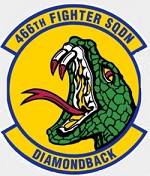Hobby Master HA2512 USAF Republic F-105 Thunderchief Fighter-Bomber - "Desert Fox," 466th Tactical Fighter Squadron, Hill Air Force Base, Utah, April 1983 (1:72 Scale)
"Tell the Vietnamese they've got to draw in their horns or we're going to bomb them back into the Stone Age. And we would shove them back into the Stone Age with Air power or Naval power - not with ground forces."
- General Curtis LeMay, May 1964
 The Republic F-105 Thunderchief was a supersonic fighter-bomber used by the United States Air Force. The Mach 2 capable F-105 bore the brunt of strike bombing over North Vietnam during the early years of the Vietnam War. Originally designed and deployed as a single seat aircraft, a two-seat Wild Weasel version was later developed for use in the specialized Suppression of Enemy Air Defenses (SEAD) role against surface-to-air missile sites. It was commonly known as the Thud by its crews.
The Republic F-105 Thunderchief was a supersonic fighter-bomber used by the United States Air Force. The Mach 2 capable F-105 bore the brunt of strike bombing over North Vietnam during the early years of the Vietnam War. Originally designed and deployed as a single seat aircraft, a two-seat Wild Weasel version was later developed for use in the specialized Suppression of Enemy Air Defenses (SEAD) role against surface-to-air missile sites. It was commonly known as the Thud by its crews.
As a follow-on to the Mach 1 capable F-100, the F-105 was also armed with missiles and a cannon; however, its design was tailored to high-speed low-altitude penetration carrying a single nuclear bomb internally. First flown in 1955, the Thunderchief entered service in 1958. As the largest single-engined fighter ever employed by the USAF, the single-seat F-105 would be adapted to deliver a greater iron bomb load than the four-engined, 10-man strategic bombers of World War II like the B-17, B-24 and B-29. The F-105 would be best remembered as the primary strike bomber over North Vietnam in the early stages of the Vietnam War. Over 20,000 Thunderchief sorties were flown, with 382 aircraft lost (nearly half of the 833 produced) including 62 operational casualties. Although it lacked the agility of the smaller MiG fighters, USAF F-105s demonstrated the effectiveness of guns, and were credited with downing 27.5 enemy aircraft.
During the war, the two-seat F-105F and F-105G Wild Weasel variants became the first dedicated Suppression of Enemy Air Defenses (SEAD) platforms, fighting against the Soviet-built S-75 Dvina / (SA-2 Guideline) surface-to-air missiles. Two Wild Weasel pilots were awarded the Medal of Honor for attacking North Vietnamese surface-to-air missile sites, with one shooting down two MiG-17s the same day. The dangerous missions often required them to be the "first in, last out," suppressing enemy air defenses and keeping them suppressed while strike aircraft accomplished their missions and then left the area.
Although the F-105 weighed 50,000 pounds (22,680 kg), the aircraft could exceed the speed of sound at sea level and Mach 2 at high altitude. It could carry up to 14,000 pounds (6,700 kg) of bombs and missiles. The Thunderchief was later replaced as a strike aircraft over North Vietnam by both the F-4 Phantom II and the swing-wing F-111. However, the "Wild Weasel" variants remained in service until 1984, when they were replaced by a specialized F-4G "Wild Weasel V". The USAF F-4G was subsequently replaced by the USAF F-16CJ Fighting Falcon aircraft, currently employed in the SEAD role.
Pictured here is a 1:72 scale rendition of a USAF Republic F-105D Thunderchief fighter-bomber that was nicknamed "Desert Fox," and attached to the 466th Tactical Fighter Squadron, then deployed to Hill Air Force Base, Utah, during April 1983.
Sold Out!
Dimensions:
Wingspan: 6-1/4-inches
Length: 10-1/2-inches
Release Date: August 2014
 Historical Account: "Diamondback" - Formed in late 1944 under Second Air Force as one of the last P-47 Thunderbolt Fighter Squadrons, programmed for deployment to Western Pacific theater with long-range P-47N for B-29 Superfortress escort missions. Arrived in Hawaii in early 1945, assigned to Seventh Air Force. Lack of a serious fighter defense over Japan at high altitudes and reprogramming of B-29 raids over Japan to night low-level fast attacks led to reassignment as a replacement training unit based in Hawaii; also performed air defense of the islands until inactivation in November 1945.
Historical Account: "Diamondback" - Formed in late 1944 under Second Air Force as one of the last P-47 Thunderbolt Fighter Squadrons, programmed for deployment to Western Pacific theater with long-range P-47N for B-29 Superfortress escort missions. Arrived in Hawaii in early 1945, assigned to Seventh Air Force. Lack of a serious fighter defense over Japan at high altitudes and reprogramming of B-29 raids over Japan to night low-level fast attacks led to reassignment as a replacement training unit based in Hawaii; also performed air defense of the islands until inactivation in November 1945.
Reactivated as Strategic Air Command fighter-escort squadron for B-50 Superfortress and B-36 Peacemaker bombers. Performed fighter-escort training throughout the 1950s, inactivated in 1956 with the phaseout of the escort mission and retirement of the B-36.
Transferred to Tactical Air Command but not activated until 1972 as an F-105 Thunderchief squadron, being equipped with aircraft returned from inactivated Vietnam War squadrons to train other tactical fighter squadrons in Wild Weasel SAM suppression tactics. Since 1984 has trained to fly interdiction, close air support, and counter-air missions. Deployed periodically for contingency operations, or for training exercises with other units.


